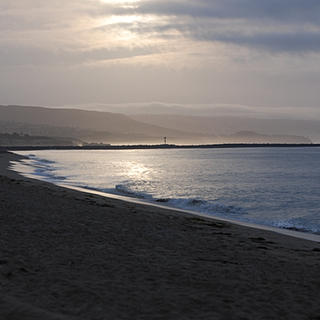Species Spotlight: Southwestern Pond Turtle
- OC Habitats
- Mar 15, 2021
- 4 min read
Updated: Apr 18, 2023
To bask on a warm log might be the loveliest of afternoon activities. The Southwestern Pond Turtle (Actinemys pallida) lives such a lavish lifestyle in California’s freshwater ecosystems. In fact, this species is the only pond turtle native to California that lives in freshwater! Native to the entire American west coast, the southwestern pond turtle is most often found in southern California. They enjoy ponds, small lakes, reservoirs, and slow-moving streams with abundant aquatic vegetation in low to medium elevation regions. This turtle is roughly the size of a dinner plate and has brown or olive shells with bright yellow eyes— a real looker.

Within these slow-moving freshwater ecosystems, the Southwestern Pond Turtle interacts with an assortment of different organisms. They will eat aquatic invertebrates like dragonflies (Anisoptera), flys (Diptera order), water boatmen (Corixidae), and others. They are omnivores who consume aquatic vegetation like Rushes (Juncus spp.), Sedges (Carex spp.), Bulrush (Scirpus spp.) and more. Occasionally, they will eat carrion; they are truly an opportunistic animal. They spend most of their time eating, swimming, and enjoying the California weather.
Although most Southwestern Pond Turtles living in southern California are active year around, some choose to hibernate for the winter. They will spend many months clustered in a shallow section of the pond to conserve energy during cold months. By slowing their metabolic processes they can hibernate until their body recognizes it’s warm enough to wake. They are mammals that use cloacal respiration, or pumping water through the cloaca through pouches that function similar to gills and extracting oxygen from the water and releasing carbon monoxide (CaliforniaHerps). This turtle nap may sound wonderful, but these periods of rest make them vulnerable to natural disasters and predators.
Their slow reproduction cycles and small appetite are perfect for maintaining a balanced ecosystem; they keep small organism populations in check without over hunting but never reproduce enough to overwhelm the ecosystem. Non-native predators like raccoons (Procyon lotor) as well as native predators such as coyotes (Canis latrans) are putting the Southwestern Pond Turtles population at risk.
The California ecosystem has evolved to resist wildfires, and the Southwestern Pond Turtles are no different. They are durable creatures with the ability to spend long periods under water; however, rising temperatures over the last 100 years have created hotter and drier seasons that exacerbate wildfires. With intensified heat of wildfires posing one threat, the turtles are also at risk from suffocating in the mudslides that occur when fire destabilizes the land. Both pose a direct threat to Southwestern Pond Turtles.

Human activity has directly impacted Southwestern Pond Turtles too, expanding urbanization threatens to destroy the ecosystem in favor of strip malls and cul-de-sacs. Besides limiting and destroying natural land, expanding construction brings long-term dangers from human activity like trash, busy roads and pollution. Pond turtles are also vulnerable to water quality, rain run-off leading to streams and ponds carrying pesticides and fertilizers from local lawns and gardens. These toxic chemicals are extremely difficult to remove and poison the Southwestern Pond Turtle slowly.
To protect the Southwestern Pond Turtle is to protect the California slow-water ecosystems. These freshwater communities are fragile and preservation efforts have been effective, but scientists worry if the worst is yet to come. The damage caused by fires, poor water quality, invasive species, human destruction, and construction can be detrimental to all species, not just the beautiful Southwestern Pond Turtle.
Recently, there have been direct and indirect efforts to protect the Southwestern Pond Turtle and their habitat. The San Diego Zoo has agreed to house a refugee population of Southwestern Pond Turtles after being collected following the Bobcat Fire. This rescue effort was a collaboration between the many agencies and organizations including Endemic Environmental, an environmental consulting company based here in Huntington Beach, CA. While none of the 8 turtles suffered burns or damage, their stay may be longer than planned due as the fire decimated the ecosystem which creates a high risk for lethal mudslides. Fortunately, the San Diego Zoo is committed to helping the species in any way.

Long-term help is coming too, carbon emissions from factories, coal, transportation and livestock production have warmed Earth's temperatures for decades and disrupted the natural weather patterns world-wide. This directly harms ecosystems like the Southwestern Pond Turtle because they are unable to adjust to increased severity in droughts, wildfires, and mudslides. In March 2021, the California Senate plans to begin hearing the Climate Corporate Accountability Act, or ‘Senate Bill 260’, which will work to hold large corporations transparent and accountable for their carbon emissions. Other national policies will be implemented too: Paris Climate Accord, conserve at least 30% of federal lands and oceans by 2030, and a Civilian Climate Corps Initiative to employ Americans to conserve land and water. On a local level, we at OC Habitats work year round to educate our community on the importance of healthy ecosystems and species, including the Southwestern Pond Turtles and their vital ecosystems. Through education, outreach and restoration of Orange County’s natural ecosystems we can help the Southwestern Pond Turtle.
There are lots of great reasons to get involved in helping preserve California ponds and streams and the native species that live there. Whether you are an expert in the field of environmental science or just someone who wants to get involved in the preservation of your community, there are many great opportunities to help out. You can find more information regarding habitat protection in Orange County and how to get involved at the OC Habitats website www.ochabitats.org







Comments